As a healthcare professional, I know how vital it is to spread the word about prostate cancer. This disease affects many men in the U.S. and it’s key to spot the early signs and know the latest treatment options. This guide will cover everything you need to know about prostate cancer symptoms, treatments, men’s health, and oncology.
Spotting prostate cancer early is the first step to getting the right medical help. We’ll talk about PSA levels, radical prostatectomy, and radiation therapy. This article aims to give you the info you need to make smart health choices. It’s for anyone worried about their health or just looking to stay updated on prostate cancer management.
Key Takeaways
- Prostate cancer is a common form of cancer that affects men, and early detection is crucial for effective treatment.
- Understanding the risk factors and causes of prostate cancer can help individuals take preventive measures.
- Regular prostate cancer screening, including PSA tests and digital rectal exams, can help detect the disease in its early stages.
- Advancements in treatment options, such as radical prostatectomy, radiation therapy, and hormone therapy, have improved the prognosis for many patients.
- Lifestyle changes and support resources can play a significant role in managing the physical and emotional aspects of prostate cancer.
Understanding Prostate Cancer
Prostate cancer is a type of cancer that affects men. It starts in the prostate gland, a small organ below the bladder. Knowing about prostate cancer helps with early detection and treatment.
What is Prostate Cancer?
Prostate cancer happens when cells in the prostate gland grow and multiply too much. This can lead to a tumor. If not caught early, it can spread to other parts of the body.
Risk Factors and Causes
Many things can make a man more likely to get prostate cancer. These include:
- Age: Older men are more likely to get prostate cancer, especially after 50.
- Family history: If your dad or brother had it, you might get it too.
- Race: African American men get prostate cancer more often and it’s usually more aggressive.
- Diet and lifestyle: Eating a lot of red meat and not enough fruits and veggies, plus being overweight, can raise your risk.
We don’t know everything about what causes prostate cancer yet. Scientists are still looking into genes and lifestyle factors that might play a part.

“Prostate cancer is the second most common cancer in American men, after skin cancer. Understanding the risk factors and potential causes is crucial for early detection and effective treatment.”
Common Prostate Cancer Symptoms
Early detection of prostate cancer is key for effective treatment and better outcomes. Knowing the common symptoms can help men spot issues early and get medical help fast. Let’s look at the main signs and symptoms of this cancer.
One key symptom is trouble urinating. This could mean a weak or interrupted flow, a sudden need to go, or needing to go more often, especially at night. These changes can happen because the tumor presses on the urethra and bladder.
Another symptom is blood in the urine or semen. This happens as the cancer grows and affects nearby organs and tissues. Even if blood in the urine or semen has other causes, it’s important to see a doctor.
Some men might feel pelvic pain or discomfort in the lower abdomen, hips, or back. This pain can get worse as the cancer gets worse. Trouble getting an erection can also be an early sign of prostate cancer.
- Difficulty urinating
- Blood in urine or semen
- Pelvic pain or discomfort
- Erectile dysfunction
Not all men with prostate cancer will have these symptoms, and some may have them without having cancer. Regular check-ups, including a PSA test and a digital rectal exam, are key for catching prostate cancer early.

“Recognizing early signs of prostate cancer can greatly improve the outcome. Men should talk to their healthcare providers about any symptoms that worry them.”
Prostate Cancer Screening and Diagnosis
Finding prostate cancer early is key for better treatment and outcomes. The process includes PSA levels, digital rectal exams, biopsies, and imaging tests. Let’s look at these steps in prostate cancer evaluation.
PSA Levels and Digital Rectal Exam
The prostate-specific antigen (PSA) blood test is a first step in screening for prostate cancer. It checks PSA levels, a protein from the prostate gland. High PSA levels might mean cancer, but they can also be from other issues. A digital rectal exam is done too, where a doctor checks the prostate gland directly.
Biopsy and Imaging Tests
If PSA tests and exams suggest prostate cancer, a biopsy comes next. A biopsy takes small prostate tissue samples for cancer cell checks. Imaging tests, like ultrasound, MRI, or CT scans, might also be used. They help see the prostate and nearby areas, guiding the biopsy and diagnosis.

Screening and diagnosing prostate cancer involves many tests and exams. Knowing about PSA levels, digital rectal exams, biopsies, and imaging tests helps men take charge of their health. This way, they can catch prostate cancer early.
Prostate Cancer Treatment Options
When dealing with prostate cancer, patients have many choices. Active surveillance is one method that’s getting more attention. It means watching the cancer closely with regular tests and scans but not treating it right away. This is often a good choice for men with low-risk cancer, helping them skip or delay harsher treatments.
Active Surveillance
Active surveillance is a way to watch prostate cancer without treating it right away. It’s suggested for men with low-risk cancer to avoid the side effects of surgery or radiation. Patients get regular PSA tests, digital rectal exams, and imaging scans to keep an eye on the cancer.
- Regular PSA tests to track changes in prostate-specific antigen levels
- Digital rectal exams to assess the size and feel of the prostate
- Periodic imaging tests, such as MRI or transrectal ultrasound, to monitor the cancer’s growth
- Repeat biopsies to ensure the cancer remains low-risk
If the cancer starts to grow during active surveillance, the patient and their doctors might look into more serious treatments like surgery or radiation. This approach lets patients avoid unnecessary treatments and their side effects while still keeping an eye on the cancer.
| Prostate Cancer Treatment | Description |
|---|---|
| Active Surveillance | Close monitoring of low-risk prostate cancer without immediate treatment |
| Radical Prostatectomy | Surgical removal of the entire prostate gland |
| Radiation Therapy | External beam radiation or brachytherapy to destroy cancer cells |
| Hormone Therapy | Medications that lower testosterone levels to slow cancer growth |
| Chemotherapy | Drugs that kill rapidly dividing cancer cells |
Radical Prostatectomy: Surgical Removal
For many men with prostate cancer, radical prostatectomy is a treatment option. This surgery removes the prostate gland and cancerous tissues around it. It’s a way to treat prostate cancer, but knowing the risks and benefits is key.
The surgery takes a few hours and is done under general anesthesia. The surgeon makes an incision, either through the belly or between the scrotum and rectum. They remove the prostate and might take out nearby lymph nodes too.
After surgery, recovery takes weeks. Patients may face side effects like not being able to control their urine, trouble getting an erection, and a chance of bleeding or infection. But, thanks to better surgery and care, many men get past these issues and live normally again.
- Radical prostatectomy is a surgery that takes out the prostate gland and nearby tissues.
- The surgery can be done through the belly or between the scrotum and rectum.
- Side effects include trouble controlling urine, issues with erections, and a risk of bleeding or infection.
- Thanks to better surgery and care, many men overcome these side effects and live normally again.
| Procedure | Description | Potential Side Effects |
|---|---|---|
| Radical Prostatectomy | Surgical removal of the prostate gland and surrounding tissues | Urinary incontinence, erectile dysfunction, risk of bleeding or infection |
Radical prostatectomy is a strong treatment for prostate cancer, but it’s vital to talk about the risks and benefits with your doctor. They can help decide if this surgery is right for you and your goals.

“Radical prostatectomy is a highly effective treatment option for many men with localized prostate cancer, but it’s important to weigh the potential benefits and risks carefully.”
Radiation Therapy for Prostate Cancer
Radiation therapy is a key treatment for prostate cancer. It uses high-energy particles or waves to kill cancer cells. This way, it helps to save healthy tissues nearby. There are two main types: external beam radiation therapy and brachytherapy.
External Beam Radiation Therapy
External beam radiation therapy (EBRT) is a non-invasive method. A machine sends radiation beams right to the prostate from outside. This treatment is given daily for a few weeks. It’s precise and can treat prostate cancer in its early stages.
Brachytherapy
Brachytherapy puts tiny radioactive seeds or pellets inside the prostate. These seeds slowly release radiation, focusing on cancer cells. It’s a good option for early-stage prostate cancer. Sometimes, it’s used with other treatments.
| Treatment | Description | Advantages |
|---|---|---|
| External Beam Radiation Therapy | Radiation beams directed at the prostate from outside the body | Precise targeting, non-invasive, can be combined with other therapies |
| Brachytherapy | Radioactive seeds implanted directly into the prostate | Targeted treatment, spares surrounding healthy tissue, can be used alone or with other therapies |
Both external beam radiation therapy and brachytherapy work well against prostate cancer. The best treatment depends on the cancer’s stage, the patient’s health, and their choices. Talking with a healthcare provider is key to finding the right treatment plan.
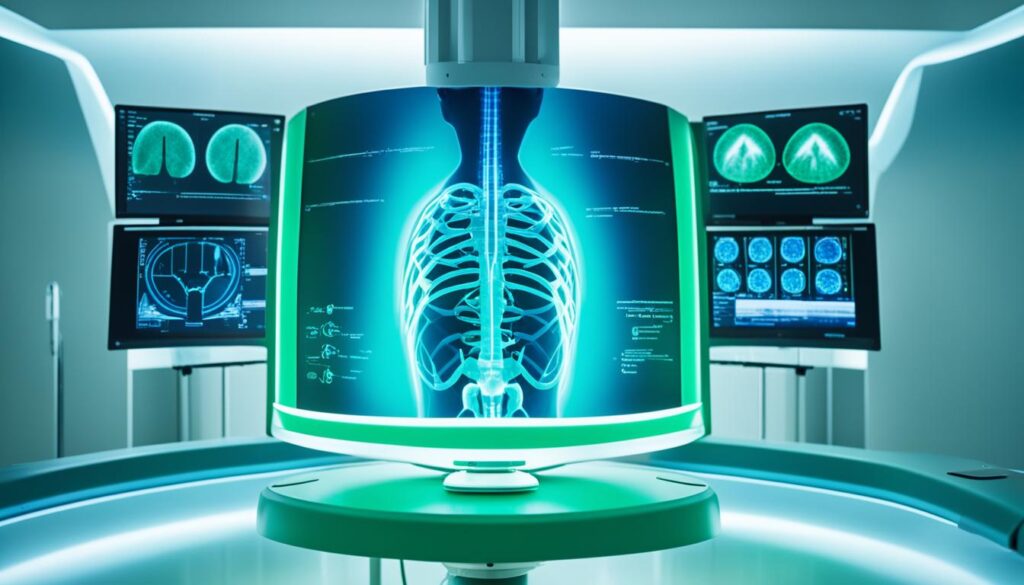
Hormone Therapy and Androgen Deprivation
Prostate cancer is a complex disease needing a detailed treatment plan. Hormone therapy and androgen deprivation are key parts of this plan. They help control the disease and improve patient outcomes.
Hormone therapy for prostate cancer uses medicines to target male hormones, or androgens. The main goal is to lower testosterone and other androgens. These hormones help prostate cancer cells grow and spread.
Androgen deprivation therapy (ADT) is a type of hormone therapy. It lowers the body’s androgen production. This can be done with medicines that stop testosterone production or block it from reaching prostate cancer cells. ADT is often used with other treatments like radiation or surgery to make them work better.
| Hormone Therapy | Androgen Deprivation Therapy (ADT) |
|---|---|
| Targets the body’s production and use of male hormones | Specifically reduces the body’s production of androgens |
| Lowers levels of testosterone and other androgens | Can be used in combination with other prostate cancer treatments |
| Aims to control the growth and spread of prostate cancer cells | Enhances the effectiveness of other prostate cancer treatments |
The choice and length of hormone therapy or ADT depend on the patient’s situation and cancer stage. Patients should talk with their healthcare team to find the best treatment plan for their prostate cancer.
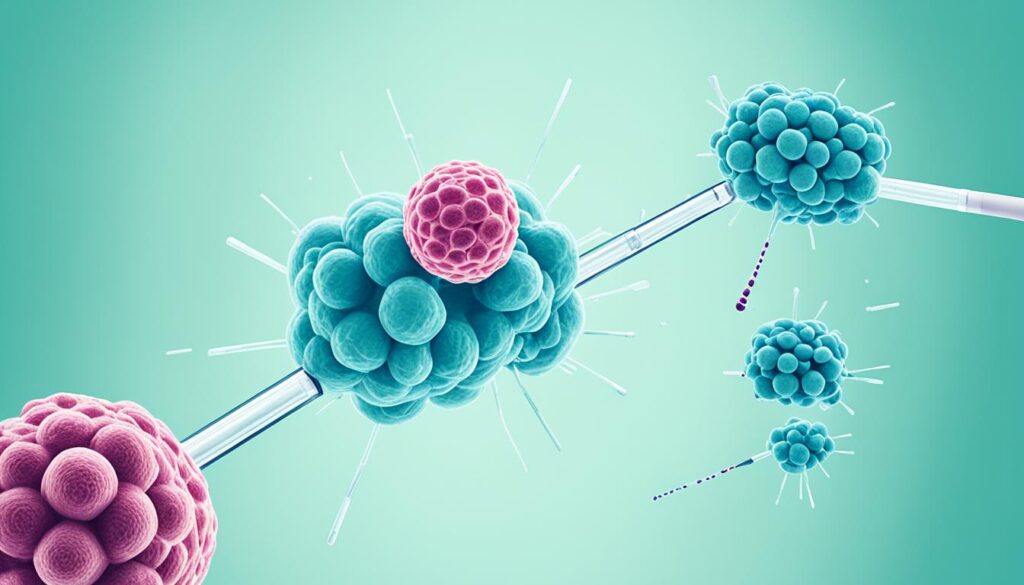
“Hormone therapy and androgen deprivation are crucial components of prostate cancer treatment, helping to control the disease and improve patient outcomes.”
Chemotherapy and Immunotherapy
Some prostate cancer cases may use chemotherapy or immunotherapy. These are good options when cancer spreads beyond the prostate or doesn’t respond to other treatments.
Chemotherapy for Prostate Cancer
Chemotherapy uses drugs to kill cancer cells by targeting fast-growing ones. It’s often used when prostate cancer is advanced or other treatments failed. Drugs like docetaxel and cabazitaxel can slow the cancer’s growth and ease symptoms.
Immunotherapy for Prostate Cancer
Immunotherapy uses the body’s immune system to fight cancer. For prostate cancer, a vaccine called sipuleucel-T helps the immune system attack cancer cells. This treatment has been shown to improve survival chances in some patients with advanced prostate cancer.
Chemotherapy and immunotherapy might not work for every prostate cancer patient. But they can be options for those with aggressive or hard-to-treat cancer. Always talk to your healthcare team to see if they’re right for you.
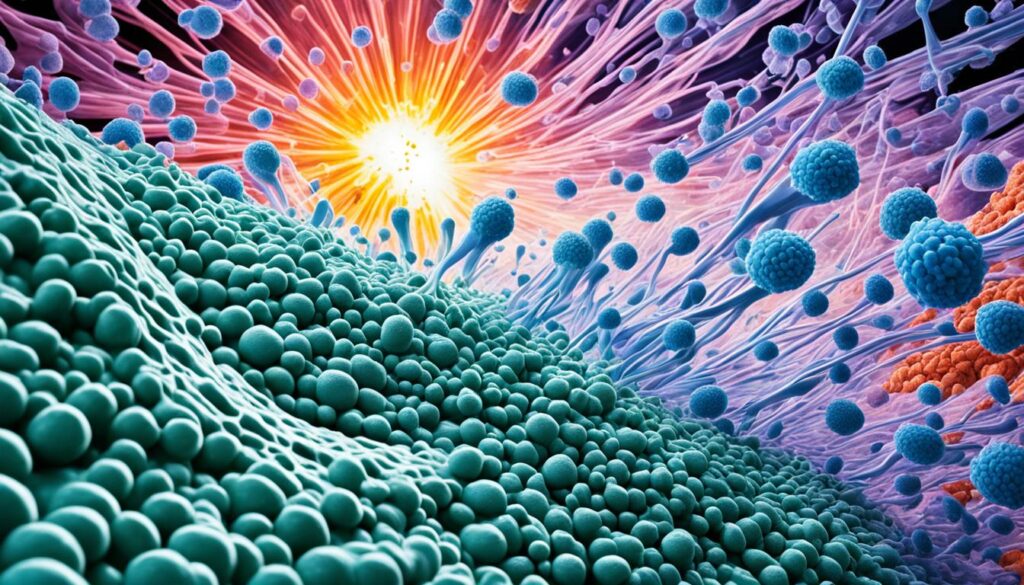
“Chemotherapy and immunotherapy are important tools in the fight against prostate cancer, especially in advanced cases. These treatments can offer new hope and improved outcomes for patients.”
Prostate Cancer Prognosis and Survival Rates
When dealing with prostate cancer, knowing about prognosis and survival rates is key. Patients and their families need to understand these factors. It helps them know what to expect and manage their hopes.
Factors Influencing Prostate Cancer Prognosis
Many things can affect how well someone with prostate cancer will do. The cancer’s stage, Gleason score, age, and other health issues are important. Catching the cancer early and treating it quickly can make a big difference.
Prostate Cancer Survival Rates
The American Cancer Society says the 5-year survival rate for prostate cancer is almost 100% for early stages. This means men with these stages have a good chance of living as long as others without cancer. But, for those with advanced cancer, the survival rate drops to about 30% after 5 years.
Thanks to better screening and treatments, survival rates have gotten better over time. Regular check-ups and talking with your doctor can help you get the best care possible.
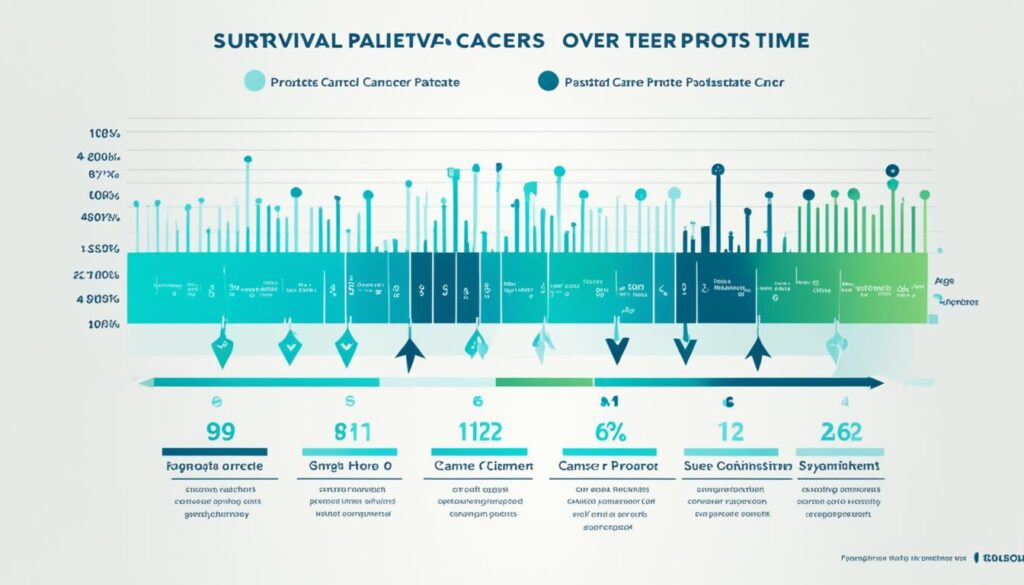
| Prostate Cancer Stage | 5-Year Relative Survival Rate |
|---|---|
| Localized | 99.9% |
| Regional | 99.5% |
| Distant (Metastatic) | 30.8% |
Prostate cancer outcomes and survival rates can differ a lot from one person to another. It’s important for patients to talk with their healthcare team. They can understand their situation better and find the best treatments.
Prostate cancer symptoms, prostate cancer treatment, men’s health, oncology
Prostate cancer is a serious condition that affects many men globally. It’s important to know the symptoms, treatment options, and how men’s health and oncology play a part. This knowledge helps in managing the disease effectively.
Early detection is crucial for prostate cancer. Symptoms include trouble urinating, seeing blood in the urine, and pain in the pelvic area. Spotting these signs early and getting medical help can greatly improve treatment outcomes.
There are various ways to treat prostate cancer, like active surveillance, surgery, radiation, hormone therapy, and chemotherapy. The best treatment depends on the cancer stage, the patient’s health, and what they prefer.
Men’s health is key when dealing with prostate cancer. Regular health checks, screenings, and talking openly with doctors help men stay on top of their health. Oncologists are experts in cancer treatment. They help manage prostate cancer and guide patients through treatment choices.
| Prostate Cancer Symptoms | Prostate Cancer Treatments |
|---|---|
|
|
Knowing about prostate cancer symptoms, treatment, and men’s health helps people take charge of their health. It also helps them work well with healthcare experts for the best results.
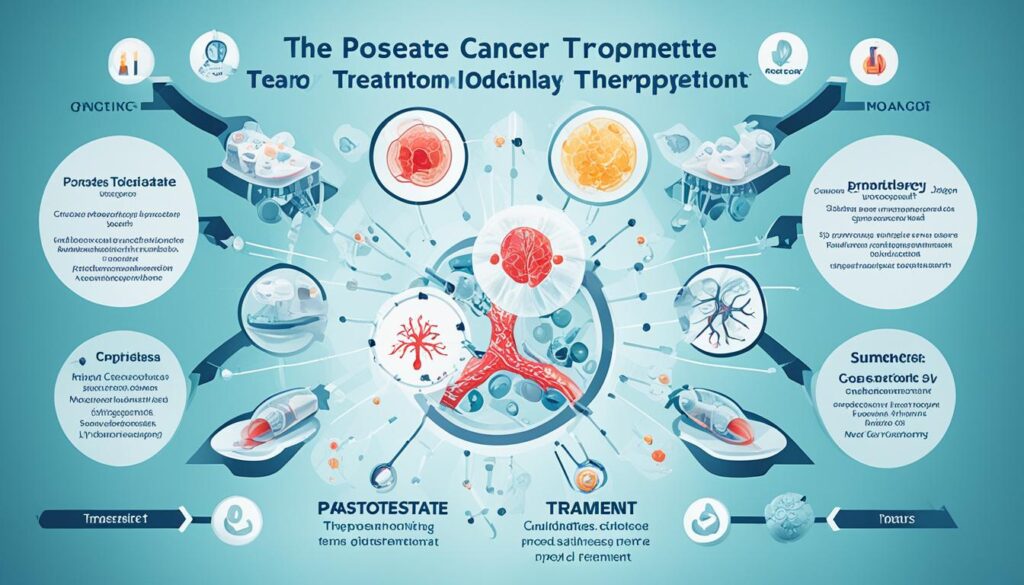
“Early detection and proper treatment are key to managing prostate cancer effectively.”
Coping with Prostate Cancer
Getting a prostate cancer diagnosis can be tough on your mind and heart. But, with the right support and resources, you can learn to handle the disease and its treatment well.
Support Groups and Resources
Connecting with a supportive community is key to coping with prostate cancer. Support groups offer a place to share stories, get emotional support, and learn from others who’ve been in your shoes. You can find these groups at local hospitals, cancer centers, or through organizations like the Prostate Cancer Foundation.
There are many resources to help you and your family during this time:
- Educational materials and info on the disease, treatments, and side effects
- Counseling and therapy to deal with the emotional and mental impact
- Financial help and advice to manage treatment costs
- Complementary therapies like yoga, meditation, and nutrition counseling for your well-being
Using these resources, you can find ways to cope and stay positive on your journey.
“The support I received from my prostate cancer support group was invaluable. Sharing my experiences with others who truly understood what I was going through made all the difference in my ability to cope.”
You’re not alone in this fight. Reaching out for support and using the resources available can greatly improve your ability to cope with prostate cancer and keep your quality of life good.
Lifestyle Changes for Prostate Cancer Patients
Prostate cancer patients can play a big part in their health by making healthy lifestyle changes. These changes can make life better and might even help with treatment and reduce the risk of the disease getting worse.
Dietary Considerations
Eating a balanced diet is key for prostate cancer patients. It’s important to eat lots of vegetables, fruits, whole grains, and lean proteins. It’s also good to eat less processed foods, red meat, and saturated fats.
Exercise and Physical Activity
Staying active is crucial for managing prostate cancer. Doing moderate exercises like walking, swimming, or cycling helps keep muscles strong, flexible, and your heart healthy. A healthcare professional can help create a safe exercise plan.
Stress Management
Prostate cancer can cause a lot of stress and anxiety. Using stress-reducing methods like meditation, yoga, or deep breathing can help patients deal with the emotional and mental challenges of the disease.
“Taking control of my lifestyle choices has been empowering in my journey with prostate cancer. It’s given me a sense of agency and has helped me feel more confident in managing the disease.”
By making these lifestyle changes, prostate cancer patients can help improve their health and well-being. This can lead to better long-term health outcomes.
Advances in Prostate Cancer Research
The study of prostate cancer is always moving forward, with new findings and better treatments. We’ll talk about the latest in fighting this disease.
Researchers are now using genomic testing to understand prostate cancer better. They look at the genes of each tumor to create treatments just for that patient. This means treatments can target the cancer’s specific mutations.
Immunotherapy is another big step forward. It uses the body’s immune system to fight cancer cells. New immunotherapy drugs are being approved for prostate cancer, helping patients who didn’t get better with old treatments.
Also, scientists are looking into targeted therapies. These treatments block the pathways that make prostate cancer grow. They aim to reduce the bad side effects of older treatments.
As prostate cancer research grows, we can expect more new and better treatments soon.
“The progress we’ve seen in prostate cancer research in recent years is truly remarkable. We’re uncovering new insights into the biology of this disease, and that’s leading to the development of increasingly targeted and personalized treatment approaches.”
| Breakthrough in Prostate Cancer Research | Potential Impact |
|---|---|
| Genomic testing to identify genetic drivers | Enables more personalized treatment plans |
| Advancements in immunotherapy | Offers new treatment options for patients |
| Development of targeted therapies | Reduces side effects compared to chemotherapy |
Choosing the Right Prostate Cancer Treatment
Finding the right prostate cancer treatment can feel overwhelming. But, making a well-informed choice is key for your health. You have many options, each with its own pros and cons.
First, understand your situation. Your doctor will look at your cancer’s stage, grade, health, and what you prefer. This helps them suggest the best treatment for you. Here are some tips for picking a treatment:
- Talk about all your treatment options with your healthcare team, including active surveillance, surgery, radiation therapy, and hormone therapy.
- Learn about the side effects and long-term effects of each treatment and how they might change your life.
- Think about what matters to you, your lifestyle, and your goals when comparing treatments.
- Keep up with the latest in prostate cancer research and treatment options, as new ones might come along.
Choosing a prostate cancer treatment should be a team effort between you and your healthcare providers. By being active in your care and considering everything, you can pick a treatment that fits your needs and likes.
| Treatment Option | Potential Benefits | Potential Drawbacks |
|---|---|---|
| Active Surveillance | Avoids immediate treatment, Preserves quality of life | Requires close monitoring, Potential for cancer progression |
| Radical Prostatectomy | Removes the prostate, Potential for long-term cure | Surgical risks, Potential for incontinence and erectile dysfunction |
| Radiation Therapy | Non-invasive, Effective for localized cancer | Potential for side effects, Longer treatment duration |
| Hormone Therapy | Slows cancer growth, Can be used in combination | Long-term side effects, May not be curative |
Choosing a prostate cancer treatment is very personal. By working with your healthcare team and thinking about everything, you can make a choice that fits you best.
“The most important thing is to have an open and honest discussion with your doctor about all the treatment options and their potential impacts on your quality of life.”
Conclusion
In this guide, we’ve covered the key parts of prostate cancer, a big health issue for men. We looked at symptoms, screening, diagnosis, and treatment options. Now, readers know more about this cancer and how to handle it.
We stressed how crucial men’s health is and the key role of oncology in fighting prostate cancer. Knowing about risks, early detection, and treatment choices helps people make smart health decisions. This way, they can keep their health in check.
As we wrap up, remember that prostate cancer can be treated. Thanks to medical research and personalized care, more people are living longer with it. By being careful, getting regular check-ups, and working with doctors, men can face this challenge bravely and with hope.







Leave feedback about this